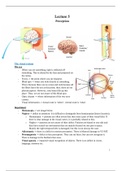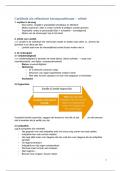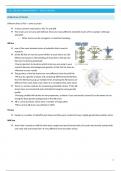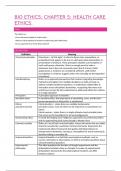Siddhant Soni ECB208 20/21
Behavioural Economics
Week 2
Chapter 3: Decision making under certainty
- Opportunity cost (implicit cost): Value of the next best alterna ve that is foregone
- If there are more than two op ons, the opportunity cost is the value of the most valuable
alterna ve op on
- c(ai ) = m a x[u(a1), u(a 2 ), . . . . ]
- Pr oposit ion : ai i s a r a t ion a l ch oice i f u(ai ) ≥ c(ai )
- Must never choose an alterna ve whose opportunity cost is higher than its u lity
- Sunk costs: Costs beyond recovery at the me when the decision was made
- Sunk cost fallacy: One can be said to honouring sunk costs or commi ng the sunk cost fallacy when
he/she makes an irra onal decision based on previously made decisions that yielded no or less than
expected u lity
- In one scenario, your corpora on has already invested $9M in the project, and you have to decide
whether to invest the addi onal $1M required to complete it. In another scenario, you have not yet
invested anything in the project, and you have to decide whether to invest the $1M required to
complete it
- If you choose to invest an addi onal 1M solely based on the previously invested 9M, then you are
honouring sunk costs
- Outlet malls are located so far away from where people live because execu ves want shoppers to think
of the sunk cost of a long drive to the mall as an investment that will be lost if they do not shop enough
- Also called the Concorde fallacy:
- The French and Bri sh governments con nued to fund the supersonic passenger jet long a er it
became clear that it would not be commercially viable, supposedly because they had already invested
so much money and pres ge in the project
- Ra onal choices must be purely forward looking (what happens at other nodes in the decision tree is
irrelevant)
- Escala on situa on: The situa on that arises when honouring sunk costs gives rise to a vicious circle
(making repeated investments on a failed project only because so much had been invested already)
- Expansion condi on (proposi on): If x is chosen from the menu {x, y}, assuming that you are not
indi erent between x and y, you must not choose y from the menu {x, y, z}
- In simple words, introduc on of an inferior product should not change your choice
Decoy e ect: When introduc on of an inferior op on, z, changes the preference of an agent from x over y
to y over x in the menu {x, y, z}
Menu Dependence: The tendency of people’s preference to change when the menu expands
tiff titiff ti ti titi ti ti titi ti tititi ti titi ti ti tti ti ti ft
, Siddhant Soni ECB208 20/21
Explana on of the decoy e ect:
- Target and compe tor; consumer prefers the compe tor
- The consumer’s choice can be manipulated by introducing a product that is inferior to the target in every
respect
- Domina on: “Product X dominates product Y if X is be er than Y in every possible respect”
- Target dominates every product in areas B and C
- Asymmetrical domina on: “Product Y is asymmetrically dominated by X if Y is dominated only by X
and not any other member from the menu”
- Thus, decoy must be superior to the compe tor in at least one respect but inferior to the target in
all respects
- Decoy: The op on that is asymmetrically dominated by the target (must be located in C)
- A rac on e ect: Occurs when the presence of the dominated op on appears to increase the
a rac veness to the consumer of the domina ng alterna ve
- The introduc on of a decoy gives the consumer a reason to reject the compe tor and to choose the
target, in that the target no longer scores lowest along either one of the two dimensions
- The introduc on of an extreme op on gives people a reason to choose the op on in the middle
- Compromise e ect: People’s tendency to choose an alterna ve that represents a compromise or
middle op on in the menu
- Extremeness aversion: People’s tendency to avoid op ons at the extremes of the relevant dimension
- Context e ects: When people’s decisions appear to be responsive to the context in which the decisions
are made
- Forms of menu dependence are described as context e ects
Endowment e ect: The tendency of people’s preferences to appear to depend on their endowment (what
they already possess)
- Also called reference point phenomena
Framing e ects: When people’s preferences depend on how the op ons are framed
- Endowment e ect and reference point phenomena are instances of framing e ects
Money illusion: “Even if you know that one Bri sh pound equals about one and a half US dollars, paying
two pounds for a drink might strike you as be er than paying three dollars”
Loss aversion: People dislike losses more than they like commensurate gains
- Endowment e ect and other reference point phenomena are explained as a result of loss aversion
- Willingness to accept (WTA): “What amount of money will you be willing to accept to give up the
good”
- WTA is evaluated in the loss frame
- Willingness to pay (WTP): “What amount of money will you be willing to pay to acquire the good,
assuming you don’t that good”
- WTP is evaluated in the gain frame
tt ti ti ffffti tifftifffftiff ti tiff ff ti ti ttti ti ti tifftt ti ti ti ti ti ti ff
, Siddhant Soni ECB208 20/21
- Standard economic theory says WTA=WTP
- Given loss aversion, WTA will always be greater than WTP
- People value something that they have more than something that they do not have
Value func on: Represents how an agent evaluates change (change = gain or loss in endowment)
- It is kinked at the origin (usually the reference point); steeper towards the le
- |v(-1)| > |v(+1)|
- If you gain something and then lose it, you may feel worse o even though you nd yourself where you
started
De ning a value func on:
{
v(x) = x /2 f or gain s (x ≥ 0)
{
= 2x f or losses (x < 0)
Important:
- To compute the change in value, you want to
compute the value of your endowment a er the
change and subtract the value of your
endowment before the change
- To compute the value of an endowment, you
must rst express the endowment as a devia on
from your reference point and not in terms of
absolute wealth or anything of the sort.
Aspira onal treadmill: The process where increasing endowments lead to irising aspira ons
- Can be use to explain why the marginal happiness of money is hardly diminishing
Indi erence curves in loss version
- Indi erence curves in standard economic theory are reversible, i.e. they re independent of endowment
- There are two indi erence curves in loss averse situa ons that re ect ini al endowment at points x and y
fiff fiti
ti ff ti ft ti ti ff fl ti ft fi ti
Behavioural Economics
Week 2
Chapter 3: Decision making under certainty
- Opportunity cost (implicit cost): Value of the next best alterna ve that is foregone
- If there are more than two op ons, the opportunity cost is the value of the most valuable
alterna ve op on
- c(ai ) = m a x[u(a1), u(a 2 ), . . . . ]
- Pr oposit ion : ai i s a r a t ion a l ch oice i f u(ai ) ≥ c(ai )
- Must never choose an alterna ve whose opportunity cost is higher than its u lity
- Sunk costs: Costs beyond recovery at the me when the decision was made
- Sunk cost fallacy: One can be said to honouring sunk costs or commi ng the sunk cost fallacy when
he/she makes an irra onal decision based on previously made decisions that yielded no or less than
expected u lity
- In one scenario, your corpora on has already invested $9M in the project, and you have to decide
whether to invest the addi onal $1M required to complete it. In another scenario, you have not yet
invested anything in the project, and you have to decide whether to invest the $1M required to
complete it
- If you choose to invest an addi onal 1M solely based on the previously invested 9M, then you are
honouring sunk costs
- Outlet malls are located so far away from where people live because execu ves want shoppers to think
of the sunk cost of a long drive to the mall as an investment that will be lost if they do not shop enough
- Also called the Concorde fallacy:
- The French and Bri sh governments con nued to fund the supersonic passenger jet long a er it
became clear that it would not be commercially viable, supposedly because they had already invested
so much money and pres ge in the project
- Ra onal choices must be purely forward looking (what happens at other nodes in the decision tree is
irrelevant)
- Escala on situa on: The situa on that arises when honouring sunk costs gives rise to a vicious circle
(making repeated investments on a failed project only because so much had been invested already)
- Expansion condi on (proposi on): If x is chosen from the menu {x, y}, assuming that you are not
indi erent between x and y, you must not choose y from the menu {x, y, z}
- In simple words, introduc on of an inferior product should not change your choice
Decoy e ect: When introduc on of an inferior op on, z, changes the preference of an agent from x over y
to y over x in the menu {x, y, z}
Menu Dependence: The tendency of people’s preference to change when the menu expands
tiff titiff ti ti titi ti ti titi ti tititi ti titi ti ti tti ti ti ft
, Siddhant Soni ECB208 20/21
Explana on of the decoy e ect:
- Target and compe tor; consumer prefers the compe tor
- The consumer’s choice can be manipulated by introducing a product that is inferior to the target in every
respect
- Domina on: “Product X dominates product Y if X is be er than Y in every possible respect”
- Target dominates every product in areas B and C
- Asymmetrical domina on: “Product Y is asymmetrically dominated by X if Y is dominated only by X
and not any other member from the menu”
- Thus, decoy must be superior to the compe tor in at least one respect but inferior to the target in
all respects
- Decoy: The op on that is asymmetrically dominated by the target (must be located in C)
- A rac on e ect: Occurs when the presence of the dominated op on appears to increase the
a rac veness to the consumer of the domina ng alterna ve
- The introduc on of a decoy gives the consumer a reason to reject the compe tor and to choose the
target, in that the target no longer scores lowest along either one of the two dimensions
- The introduc on of an extreme op on gives people a reason to choose the op on in the middle
- Compromise e ect: People’s tendency to choose an alterna ve that represents a compromise or
middle op on in the menu
- Extremeness aversion: People’s tendency to avoid op ons at the extremes of the relevant dimension
- Context e ects: When people’s decisions appear to be responsive to the context in which the decisions
are made
- Forms of menu dependence are described as context e ects
Endowment e ect: The tendency of people’s preferences to appear to depend on their endowment (what
they already possess)
- Also called reference point phenomena
Framing e ects: When people’s preferences depend on how the op ons are framed
- Endowment e ect and reference point phenomena are instances of framing e ects
Money illusion: “Even if you know that one Bri sh pound equals about one and a half US dollars, paying
two pounds for a drink might strike you as be er than paying three dollars”
Loss aversion: People dislike losses more than they like commensurate gains
- Endowment e ect and other reference point phenomena are explained as a result of loss aversion
- Willingness to accept (WTA): “What amount of money will you be willing to accept to give up the
good”
- WTA is evaluated in the loss frame
- Willingness to pay (WTP): “What amount of money will you be willing to pay to acquire the good,
assuming you don’t that good”
- WTP is evaluated in the gain frame
tt ti ti ffffti tifftifffftiff ti tiff ff ti ti ttti ti ti tifftt ti ti ti ti ti ti ff
, Siddhant Soni ECB208 20/21
- Standard economic theory says WTA=WTP
- Given loss aversion, WTA will always be greater than WTP
- People value something that they have more than something that they do not have
Value func on: Represents how an agent evaluates change (change = gain or loss in endowment)
- It is kinked at the origin (usually the reference point); steeper towards the le
- |v(-1)| > |v(+1)|
- If you gain something and then lose it, you may feel worse o even though you nd yourself where you
started
De ning a value func on:
{
v(x) = x /2 f or gain s (x ≥ 0)
{
= 2x f or losses (x < 0)
Important:
- To compute the change in value, you want to
compute the value of your endowment a er the
change and subtract the value of your
endowment before the change
- To compute the value of an endowment, you
must rst express the endowment as a devia on
from your reference point and not in terms of
absolute wealth or anything of the sort.
Aspira onal treadmill: The process where increasing endowments lead to irising aspira ons
- Can be use to explain why the marginal happiness of money is hardly diminishing
Indi erence curves in loss version
- Indi erence curves in standard economic theory are reversible, i.e. they re independent of endowment
- There are two indi erence curves in loss averse situa ons that re ect ini al endowment at points x and y
fiff fiti
ti ff ti ft ti ti ff fl ti ft fi ti











